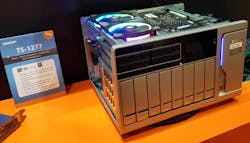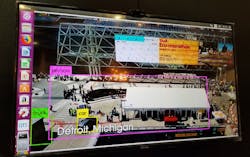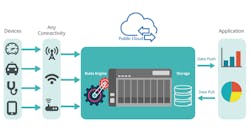QNAP is well known for delivering network attached storage (NAS) devices. They range from small boxes that handle a few drives to larger systems that can support a mix of solid state and hard disk storage designed for the enterprise. Systems like its new TS-1277 (Fig. 1) can pack eight 3.5-in drives and four 2.5-in drives. It includes modular cooling support and PCI Express slots that peripheral cards like GPUs can be added to the mix. The TS-1277 runs an AMD Ryzen 7 1700 processor with a high-end graphics card installed.
1. TS-1277 runs an AMD Ryzen 7 1700 processor with a high-end graphics card installed.
Normally a NAS box has an operating system and a file server application. Most have additional features like web servers, backup services, and similar file related features. QNAP includes all these in addition to providing redundancy and other storage-related options.
QNAP’s management interface has gotten significantly more robust as it has added more processing power and memory to their systems. It already supports virtual machines as well as LXC and Docker containers. This essentially moves QNAP from being just a storage provider to a server provider. This can be quite handy for users ,since QNAP’s solutions tend to be plug-and-play. Just add the drives to the system and everything works.
Lately the company have been adding some interesting software to the mix to take advantage of the processing power, like the GPUs found in platforms like the TS-1277. At this year’s Consumer Electronics Show, QNAP was showing off QuAI, an artificial intelligence (AI) package that allows developers “to quickly build, train, and optimize AI models running on QNAP NAS products.” The image classification demo (Fig. 2) was identifying objects in real time.
2. The QuAI artificial intelligence (AI) package allows developers to build, train and optimize AI models like this streaming video analysis.
The QuAI support is built on QNAP’s container support (Fig. 3). It supports the popular machine learning (ML) frameworks, including CNTK, MXNet, TensorFlow, and Caffe. Using one of these frameworks is as easy as selecting and creating a matching container. This support works with standard GPGPUs like those from NVidia. A NAS box is a good match for AI applications because of the storage needed for related data used when training models.
3. The QuAI support is built on QNAP’s container support and takes advantage of the system’s GPGPU card.
The QIoT Container is can handle applications other than AI. It can also deliver a private cloud for IoT applications (Fig. 4). The system supports IoT protocols like MQTT, HTTP, COAP, and AMQP. The NAS boxes already provide storage in a reliable and secure fashion. It supports the open-source Eclipse Ponte, and multiple instances can be running for high availability (HA) environments. Ponte is built on Node.JS, an event-driven, non-blocking I/O model. This new support allows microservices to run on the NAS box. QIoT can also be integrated with public cloud solutions.4. QIoT Container can be used to build up a private IoT cloud system, complete with a rules engine that links data with devices and applications.
QNAP has move well past NAS devices that just provide storage but it has maintained the ease of use normally associated with NAS boxes.
About the Author
William G. Wong
Senior Content Director - Electronic Design and Microwaves & RF
I am Editor of Electronic Design focusing on embedded, software, and systems. As Senior Content Director, I also manage Microwaves & RF and I work with a great team of editors to provide engineers, programmers, developers and technical managers with interesting and useful articles and videos on a regular basis. Check out our free newsletters to see the latest content.
You can send press releases for new products for possible coverage on the website. I am also interested in receiving contributed articles for publishing on our website. Use our template and send to me along with a signed release form.
Check out my blog, AltEmbedded on Electronic Design, as well as his latest articles on this site that are listed below.
You can visit my social media via these links:
- AltEmbedded on Electronic Design
- Bill Wong on Facebook
- @AltEmbedded on Twitter
- Bill Wong on LinkedIn
I earned a Bachelor of Electrical Engineering at the Georgia Institute of Technology and a Masters in Computer Science from Rutgers University. I still do a bit of programming using everything from C and C++ to Rust and Ada/SPARK. I do a bit of PHP programming for Drupal websites. I have posted a few Drupal modules.
I still get a hand on software and electronic hardware. Some of this can be found on our Kit Close-Up video series. You can also see me on many of our TechXchange Talk videos. I am interested in a range of projects from robotics to artificial intelligence.






